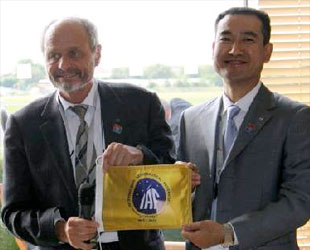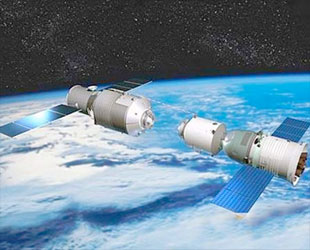September 29, 2011 — China launched its first space lab Thursday (Sept. 29), the Tiangong-1 unmanned module, on a two-year mission to test technologies needed to build the nation's first space station. The 8.5-ton (17,000-pound) spacecraft also returned to space a commemorative cargo that was earlier flown aboard both American and Russian spacecraft to and from the International Space Station.
Tiangong-1 lifted off atop a Long March 2F rocket at 9:16 p.m. local time (1316 GMT/8:16 a.m. CDT) Thursday from China's Jiuquan Satellite Space Center in the Gobi desert. Now circling the planet, the module will await the arrival of Shenzhou 8, an unmanned capsule scheduled to launch in November, to perform a series of rendezvous and docking demonstrations.
Two additional capsules, at least one of them crewed, are planned to visit Tiangong-1 over the next two years before the 34-foot long (10.4 meter) module is de-orbited.
Tiangong-1's launch marks the latest milestone for China's human spaceflight program, which began in 2003 with the flight of taikonaut Yang Liwei on the Shenzhou 5 mission. Just the third nation to put a human into space, China has since launched two more crewed flights – the most recent in 2008 highlighted by the country's first spacewalk – and intends to be the third nation to deploy a space station.
Packed on board Tiangong-1 are 300 flags that previously flew aboard spacecraft belonging to Russia and the United States, the two countries that preceded China into space.
Around the world in three ways

International Astronautical Federation (IAF) president Berndt Feuerbacher (left) and taikonaut Zhai Zhigang hold one of the 300 flags that are now in space onboard Tiangong-1. (Xinhua) |
The small yellow and blue flags celebrate the International Astronautical Federation's (IAF) first 60 years serving as a worldwide coalition of organizations active in space. They were presented to China to fly on Tiangong-1 at this year's Paris Air Show, where IAF president Berndt Feuerbacher presented them to Shenzhou 7 spacewalker Zhai Zhigang.
Last year, the same flags were launched on Russia's Soyuz TMA-20 spacecraft to fly to the International Space Station. Roscosmos cosmonaut Dmitri Kondratyev, NASA astronaut Catherine "Cady" Coleman and European Space Agency astronaut Paolo Nespoli delivered the flags to the orbiting complex in December 2010, where they remained for five months.
On June 1, 2011, the IAF flags returned to Earth on board the U.S. space shuttle Endeavour flying its final mission. Endeavour's commander Mark Kelly and his five STS-134 crewmates landed with the flags after completing a 12-day mission to install the Alpha Magnetic Spectrometer on the space station, a science experiment built in 16 countries, including China.
By the end of their first spaceflight, the 300 IAF flags had logged 169 days in space.
With their second launch on board Tiangong-1, the flags have now fulfilled the IAF's desire that they fly on "all types of active manned spacecrafts in the world." They are slated to be returned in 2012 by the yet-to-be-named crew aboard Shenzhou 10, which may include China's first female taikonaut, Chinese space officials have said.
Upon receiving them back, the IAF has said it will give a flown flag to each of its member organizations, "so as to promote human peaceful use of outer space and develop international cooperation for manned space," Feuerbacher said.
Heavenly Palace

An artist's concept of a Shenzhou spacecraft (right) docking with China's first space lab, Tiangong-1, above Earth. (CMSE) |
In addition to the flags, Tiangong-1, which translates to "Heavenly Palace," is also flying medical and engineering experiments into space.
"The main tasks of [our] Tiangong-1 space flight include: provide a target vehicle for space rendezvous and docking experiment; primarily establish a manned space platform capable of long-term unmanned operation in space with temporary human attendance; to carry out space science, medical and technology experiments," said spokeswoman Wu Ping for China's Manned Space Engineering Office.
The first docking tests with Shenzhou 8 are scheduled to begin in early November during a two-week mission. China plans, according to Wu, for the unmanned crew capsule to berth with Tiangong-1 at least twice.
Shenzhou 9 and Shenzhou 10 would follow, launching in 2012 on similar missions. One or both however, could be manned, according to state media.
"The implementation of [a] space rendezvous and docking mission, as well as the breakthrough and mastering of rendezvous and docking technology are the basis and premise for the construction of manned space station," Wu said. "It is of great significance for the realization of [the] China Manned Space Engineering Project and the promotion of sustainable development of manned space flight."
